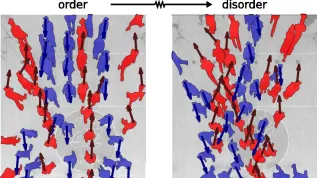
Crowds of people heading in different directions meet at pedestrian crossings, stations and stadiums. Just like particles of matter in colloids or substances in some cells, these people spontaneously form traffic lanes. Researchers from Poland and the UK have just described the mathematical rules of this unusual dance in a publication in Science.
Laymen may be amazed by the order that emerges with every step from a disordered collection of objects, and mathematics enthusiasts will additionally appreciate that in such unobvious circumstances, lines from the family of conic curves spontaneously appear: ellipses, parabolas and hyperbolas.
LANES ACROSS THE ROAD
Imagine a busy pedestrian crossing: half of the people crowd on one side of the street, and the other half on the opposite side. Everyone wants to cross the road without bumping into others. It turns out that when the light turns green and people cross the road, they spontaneously form lanes - sometimes there are more lanes, sometimes there are fewer, but generally they are parallel to each other and to the walking direction of passers-by. The person 'blazing a trail' to the other side is followed by other people who are also going in the same direction.
This observation has been known for a long time and reproduced in various experiments. In 2021, the igNobel Prize was awarded for showing that if passers-by stare at smartphones, the process of such lanes emerging is disrupted.
BEAM AT THE INTERSECTION
A lesser known experiment is what happens at the crossroads of lanes of two groups of people. Mathematician Dr. Karol Bacik from the University of Bath told PAP that this is what it looks like at King's Cross station in London. Travellers enter the station through entrances set at right angles to the exit gates, which travellers leaving the station try to reach. In this situation, traffic lanes also emerge spontaneously, but they run diagonally to both gates.
Tilted lanes captured in a human-crowd experiment. The lanes are formed by two groups of people moving in opposite directions. The inclination results from a 'pass on the right' traffic rule. Credit: Karol Bacik, Bogdan Bacik, Tim Rogers, publication in Science
THE LANES HAVE A NICE PATTERN
In a paper published in Science, scientists led by Professor Tim Rogers of the University of Bath mathematically described the rules of such an emergent dance of passers-by in various other frames of reference. They presented a mathematical analysis of how such lanes looked in different situations.
Dr. Bacik said that the equations include: crowd density, slowing down of movement by the pressing crowd, and sometimes a random 'diffusion' of agents to the sids to avoid collisions.
The proposed mathematical description can be used not only to describe the movement of passers-by, but also particles in colloids or the transport of particles in elongated cells, e.g. nerve cells. Even among particles that are not endowed with consciousness or the ability to plan, order can emerge spontaneously from the initial disorder.
PASSERS-BY DANCE ON A CONE
Researchers from the UK and Poland were the first to show that sometimes lanes can spontaneously take the shape of certain characteristic curved lines. So if, for example, two groups are heading for two exits located on two sides of the room, the lanes will take the shape of a segment of an ellipse.
If, however, one group is going from the bottom to the top of the room, and the other group is heading to the exit on the side of the room at the same time, the traffic lanes can take the shape of a parabola.
On the other hand, if one group enters the room through one passage and goes to the other side, on the way meeting another group heading to another exit - the lanes can be in the shape of a hyperbola.
Dr. Bacik said: “So we have ellipses, hyperbolas and parabolas. When mathematicians hear this, their hearts probably melt, because these curves belong to one family - conic curves.”
He added that if you take a cone and cut it with a plane at different angles, the edges of this solid will determine different shapes on the plane. If the tip of a cone is cut off parallel to the base of the cone, the curve will be a circle, if the cut is made at a small angle to the base it will be an ellipse, at a larger angle - a parabola, and at an even larger angle (closer to the vertical) - a hyperbola. All these curves can be described with a second degree equation.
Dr. Bacik said: “Circular lanes are unlikely, but all other popular members of this family of curves appear in our experiments.”
THE BACIK FAMILY STUDIES A FAMILY OF CURVES
Scientists verified theoretical predictions in experiments with a real crowd - a group of subjects at the Academy of Physical Education in Katowice conducted by Bacik’s father Dr. Bogdan Bacik. He said: “These experiments were conducted by my dad, who is a biomechanics expert. I did not think that I, a mathematician, would one day work with him on a joint research project.”
ACIDS RELATED TO BASES
Researchers also checked what would happen if top-down rules were introduced to the spontaneous movement of passers-by: for example, passers-by - as in road traffic - should always be passed on the right side. In this situation, lanes also formed, but they ran diagonally - they were 'tilted' to the right. As a result, the path taken by passers-by became longer than when there were no rules. Back said: “So you can see that sometimes introducing rules hinders movement instead of facilitating it.”
He added that many problems have already been described in which, under certain conditions, a regular pattern emerges from what appears to be a chaotic mass. These problems include why the zebra is not grey but instead has black and white stripes, and why regular ripples form in the beach sand.
Back said: “We show that lane formation can also be included in this catalogue of phenomena.”
PAP - Science in Poland, Ludwika Tomala
lt/ zan/ kap/
tr. RL













